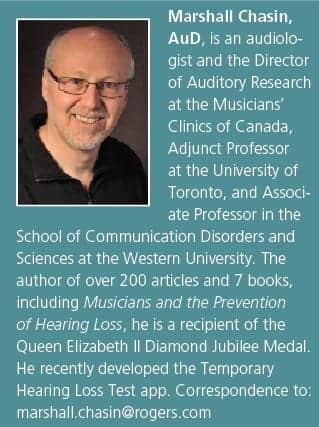Back to Basics | March 2017 Hearing Review
By Marshall Chasin, AuD
Clinically we all need to walk the fine line between the “values” of our clientele and “facts.” I ran into this problem recently where a well-meaning, but perhaps misinformed, musician wanted as much low-end in his hearing aid amplification as he could get. His personal “value” was that a broader bandwidth is always better—after all “half of the piano keys are below middle C” with middle C having its fundamental at 262 Hz. In fact, that’s why we have the bass clef. Yet, clinicians know that, if we were to do this, the musician (and anyone fitted this way) would rip the hearing aids out of their ears.
The “fact” part of this balance is that in most hearing aid fittings, significant unamplified low frequency energy is heard which bypasses the hearing aid, entering directly through the hearing aid vent. Whether the sound has been amplified or merely allowed to enter the ear is irrelevant; it is still available to the hard-of-hearing person.
Of course, there are some minor technical differences, and indeed there may be occasional undesired resonances and anti-resonances caused by the interplay between the two sound paths. But, overall, these are of minimal importance, especially when listening to higher level inputs associated with music.
And in order to have significant amplified low frequency sound there needs to be significant occlusion, resulting in the occlusion effect and poor sound quality of a person’s own voice (and/or woodwind or brass musical instrument).
The final element of the “fact” side of the equation is the psychophysical property called the “missing fundamental.” In addition to perceiving the absolute value of the frequency, our auditory system also locks onto differences in sound energy. A 50 Hz difference between 50 Hz and 100 Hz, can also be perceived as that same 50 Hz difference between 2000 Hz and 2050 Hz. We don’t need to hear low frequency sound information in order to perceive low frequency sound information.
Despite these “facts” it is never an easy task to re-educate a musician. And this fine line between “fact” and “value” is not always clear.
Another example of this is the move in the United States to allow over-the-counter (OTC) hearing aids to be dispensed, bypassing the hearing healthcare professional. The values of the consuming public are mother and apple pie: good value with easy and universal access. It is understandable that an OTC approach could fulfill these values, but the facts tell a different story.
In particular, there has been great confusion between “conductive” hearing losses and “sensory neural” hearing losses in the analogies of OTC proponents. Myopia, which may require eyeglasses to correct it, is a conductive problem—light is not properly conducted to the sensory organ of the eye. Changing where light impinges on the retina corrects the problem. Myopia requires merely a refocusing of the light to be resolved (ie, the lenses of glasses), often close to 20/20 vision.
I would agree that an OTC approach could also be used for conductive hearing loss where the sound volume just needs to be turned up. Practically, in cases of conductive visual or conductive hearing loss, there is no maximum light level or sound level that typically needs to be an issue.
In contrast, the vast majority of hearing loss is sensorineural, which is akin to macular degeneration. Resolution of this problem requires significant prescription, counseling, and fine-tuning. In addition, assistive visual and listening devices may be required.
Unlike a conductive hearing loss, the maximum input for a sensorineural loss needs to be carefully controlled and limited. Too high a level and the device may not be worn, and there is a significant chance of over-amplification with associated further hearing deterioration.

Eyeglasses are for conductive losses. Hearing aids are for sensorineural losses. The two are quite different pathologies that require quite different levels and models of intervention.
Original citation for this article: Chasin M. Facts vs Values: Faulty analogies in the rationale for OTC devices. Hearing Review. 2017;24(3):10.





